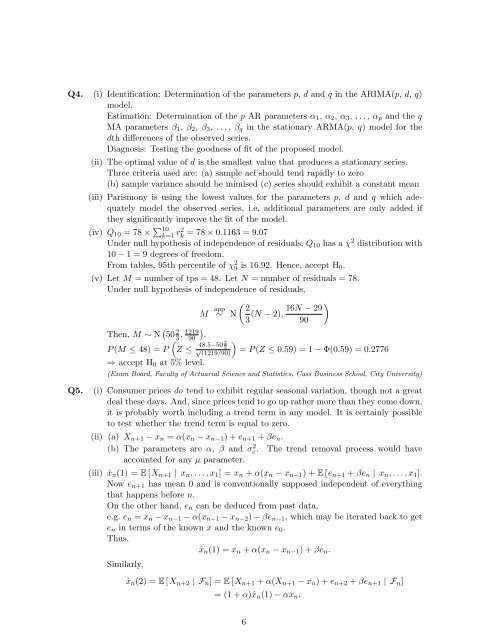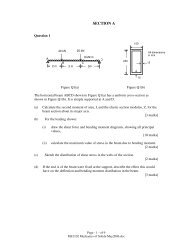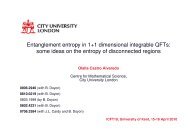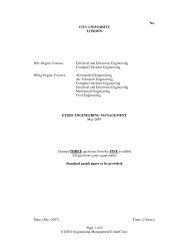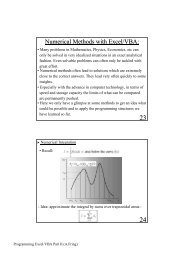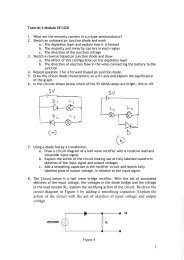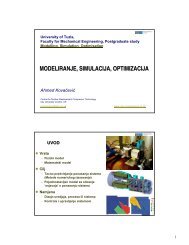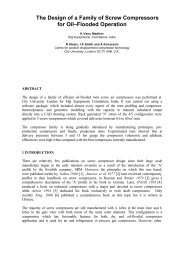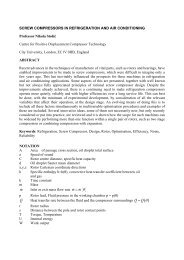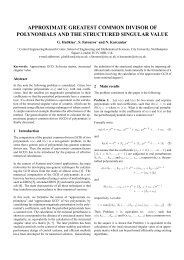Stochastic Modelling Solutions to Exercises on Time Series∗
Stochastic Modelling Solutions to Exercises on Time Series∗
Stochastic Modelling Solutions to Exercises on Time Series∗
Create successful ePaper yourself
Turn your PDF publications into a flip-book with our unique Google optimized e-Paper software.
Q4. (i) Identificati<strong>on</strong>: Determinati<strong>on</strong> of the parameters p, d and q in the ARIMA(p, d, q)<br />
model.<br />
Estimati<strong>on</strong>: Determinati<strong>on</strong> of the p AR parameters α 1 , α 2 , α 3 , . . . , α p and the q<br />
MA parameters β 1 , β 2 , β 3 , . . . , β q in the stati<strong>on</strong>ary ARMA(p, q) model for the<br />
dth differences of the observed series.<br />
Diagnosis: Testing the goodness of fit of the proposed model.<br />
(ii) The optimal value of d is the smallest value that produces a stati<strong>on</strong>ary series.<br />
Three criteria used are: (a) sample acf should tend rapidly <str<strong>on</strong>g>to</str<strong>on</strong>g> zero<br />
(b) sample variance should be mimised (c) series should exhibit a c<strong>on</strong>stant mean<br />
(iii) Parism<strong>on</strong>y is using the lowest values for the parameters p, d and q which adequately<br />
model the observed series, i.e. additi<strong>on</strong>al parameters are <strong>on</strong>ly added if<br />
they significantly improve the fit of the model.<br />
(iv) Q 10 = 78 × ∑ 10<br />
k=1 r2 k<br />
= 78 × 0.1163 = 9.07<br />
Under null hypothesis of independence of residuals, Q 10 has a χ 2 distributi<strong>on</strong> with<br />
10 − 1 = 9 degrees of freedom.<br />
From tables, 95th percentile of χ 2 9 is 16.92. Hence, accept H 0.<br />
(v) Let M = number of tps = 48. Let N = number of residuals = 78.<br />
Under null hypothesis of independence of residuals,<br />
( )<br />
M app 2 16N − 29<br />
∼ N (N − 2),<br />
3 90<br />
Then, M ∼ N ( 50 2 3 , 1219 )<br />
90 .<br />
(<br />
)<br />
P (M ≤ 48) = P Z ≤ 48.5−50 2 √ 3<br />
(1219/90)<br />
= P (Z ≤ 0.59) = 1 − Φ(0.59) = 0.2776<br />
⇒ accept H 0 at 5% level.<br />
(Exam Board, Faculty of Actuarial Science and Statistics, Cass Business School, City University)<br />
Q5. (i) C<strong>on</strong>sumer prices do tend <str<strong>on</strong>g>to</str<strong>on</strong>g> exhibit regular seas<strong>on</strong>al variati<strong>on</strong>, though not a great<br />
deal these days. And, since prices tend <str<strong>on</strong>g>to</str<strong>on</strong>g> go up rather more than they come down,<br />
it is probably worth including a trend term in any model. It is certainly possible<br />
<str<strong>on</strong>g>to</str<strong>on</strong>g> test whether the trend term is equal <str<strong>on</strong>g>to</str<strong>on</strong>g> zero.<br />
(ii) (a) X n+1 − x n = α(x n − x n−1 ) + e n+1 + βe n .<br />
(b) The parameters are α, β and σe.<br />
2 The trend removal process would have<br />
accounted for any µ parameter.<br />
(iii) ˆx n (1) = E [X n+1 | x n , . . . , x 1 ] = x n + α(x n − x n−1 ) + E [e n+1 + βe n | x n , . . . , x 1 ].<br />
Now e n+1 has mean 0 and is c<strong>on</strong>venti<strong>on</strong>ally supposed independent of everything<br />
that happens before n.<br />
On the other hand, e n can be deduced from past data,<br />
e.g. e n = x n − x n−1 − α(x n−1 − x n−2 ) − βe n−1 , which may be iterated back <str<strong>on</strong>g>to</str<strong>on</strong>g> get<br />
e n in terms of the known x and the known e 0 .<br />
Thus,<br />
ˆx n (1) = x n + α(x n − x n−1 ) + βe n .<br />
Similarly,<br />
ˆx n (2) = E [X n+2 | F n ] = E [X n+1 + α(X n+1 − x n ) + e n+2 + βe n+1 | F n ]<br />
= (1 + α)ˆx n (1) − αx n .<br />
6


